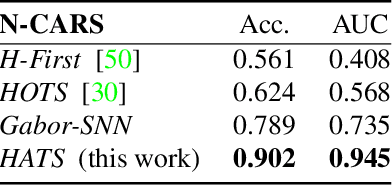Xavier Lagorce
GS-EVT: Cross-Modal Event Camera Tracking based on Gaussian Splatting
Sep 28, 2024Abstract:Reliable self-localization is a foundational skill for many intelligent mobile platforms. This paper explores the use of event cameras for motion tracking thereby providing a solution with inherent robustness under difficult dynamics and illumination. In order to circumvent the challenge of event camera-based mapping, the solution is framed in a cross-modal way. It tracks a map representation that comes directly from frame-based cameras. Specifically, the proposed method operates on top of gaussian splatting, a state-of-the-art representation that permits highly efficient and realistic novel view synthesis. The key of our approach consists of a novel pose parametrization that uses a reference pose plus first order dynamics for local differential image rendering. The latter is then compared against images of integrated events in a staggered coarse-to-fine optimization scheme. As demonstrated by our results, the realistic view rendering ability of gaussian splatting leads to stable and accurate tracking across a variety of both publicly available and newly recorded data sequences.
HATS: Histograms of Averaged Time Surfaces for Robust Event-based Object Classification
Mar 21, 2018



Abstract:Event-based cameras have recently drawn the attention of the Computer Vision community thanks to their advantages in terms of high temporal resolution, low power consumption and high dynamic range, compared to traditional frame-based cameras. These properties make event-based cameras an ideal choice for autonomous vehicles, robot navigation or UAV vision, among others. However, the accuracy of event-based object classification algorithms, which is of crucial importance for any reliable system working in real-world conditions, is still far behind their frame-based counterparts. Two main reasons for this performance gap are: 1. The lack of effective low-level representations and architectures for event-based object classification and 2. The absence of large real-world event-based datasets. In this paper we address both problems. First, we introduce a novel event-based feature representation together with a new machine learning architecture. Compared to previous approaches, we use local memory units to efficiently leverage past temporal information and build a robust event-based representation. Second, we release the first large real-world event-based dataset for object classification. We compare our method to the state-of-the-art with extensive experiments, showing better classification performance and real-time computation.
STICK: Spike Time Interval Computational Kernel, A Framework for General Purpose Computation using Neurons, Precise Timing, Delays, and Synchrony
Jul 22, 2015Abstract:There has been significant research over the past two decades in developing new platforms for spiking neural computation. Current neural computers are primarily developed to mimick biology. They use neural networks which can be trained to perform specific tasks to mainly solve pattern recognition problems. These machines can do more than simulate biology, they allow us to re-think our current paradigm of computation. The ultimate goal is to develop brain inspired general purpose computation architectures that can breach the current bottleneck introduced by the Von Neumann architecture. This work proposes a new framework for such a machine. We show that the use of neuron like units with precise timing representation, synaptic diversity, and temporal delays allows us to set a complete, scalable compact computation framework. The presented framework provides both linear and non linear operations, allowing us to represent and solve any function. We show usability in solving real use cases from simple differential equations to sets of non-linear differential equations leading to chaotic attractors.
 Add to Chrome
Add to Chrome Add to Firefox
Add to Firefox Add to Edge
Add to Edge